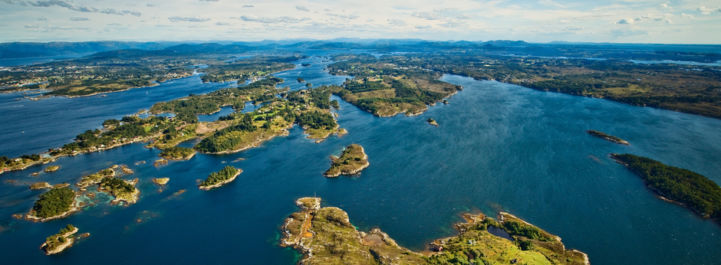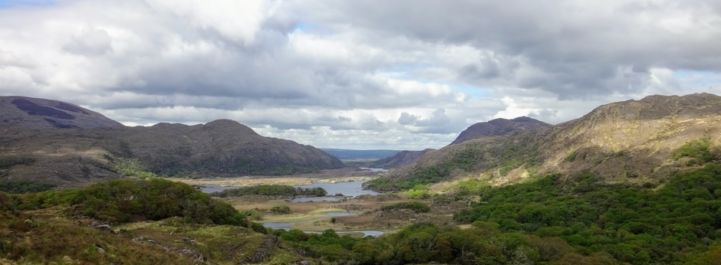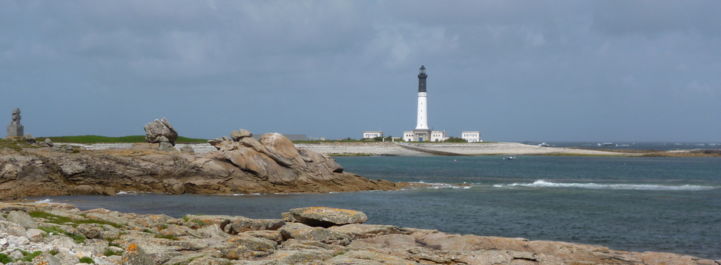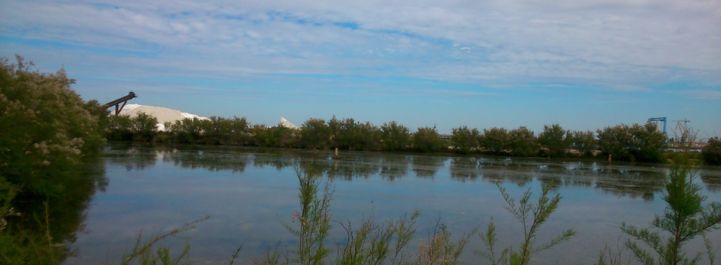5 unmissable UNESCO Biosphere Reserves cycling EuroVelo 1 - Atlantic Coast Route
Biosphere reserves include terrestrial, marine and coastal ecosystems. Each site promotes solutions reconciling the conservation of biodiversity with its sustainable use for human activities. Cycling, together with hiking, are two of the best types of tourist activities to perform in these areas, as they have minimal environmental impacts. Tourism in this form can help to maintain the balance; thereby allowing nature and communities to thrive.
Nordhordland in Norway
Green Travel is a pillar of Norway’s tourism, if travelling with a low environmental impact is also important for you; you shall be happy to hear that Norway has a certification scheme for Sustainable Destinations. If you’re eager to experience a unique destination that also cares for the local environment by ensuring that tourists footprint remains as low as possible you can do so by looking for the ‘sustainable destinations' label. In doing so improve your experience by helping to preserve local communities and cultural heritage while ensuring the destinations remain an enjoyable place to both live and visit.
On the way to Bergen from the starting point of EuroVelo 1 in Norway: The North Cape you have the opportunity to explore the Nordhordland UNESCO Biosphere Reserve. The reserve, that is characterised by a rich diversity of ecosystems, is centrally located on the coast of western Norway and is comprised of the coastal landscape between Bergen and Sognefjorden. It stretches from the Atlantic Ocean in the west, covers the outer coastal archipelago, as well as hundreds of fjords and inlets and ends in the mountains 1300 m above sea level in the east. Water is a central theme of this biosphere reserve, as water has been essential for shaping the natural features of the region, and is a resource that in its many forms (as lakes, rivers and fjords) sustains its people and traditions.
The ecosystems here are characterised by the deep ocean linked to the Norwegian Trench and the Norwegian Continental Shelf. The sea has clean, clear, Atlantic water with a high salt content. In the ocean depths are deep-water corals and, further in, large kelp forests. In addition to Lindåsosane – a system of small, shallow fjords – three major fjords stand out: the national salmon fjords of the island of Osterøy, Masfjorden, and Lurefjorden. The freshwater systems here are characterised by a high diversity within the river systems flowing from the mountains to the fjords.
Allow yourself to experience the wilderness and the immensity of the fjords, whilst crossing them with your bike using the many bridges and ferries that connect these incredible landscapes.

Kerry Biosphere reserve in the Republic of Ireland
The Irish Atlantic Coast is known as the Wild Atlantic Way, if this title sounds appealing to you then you should definitely plan a cycling holiday into the wilds of the Emerald Isle. Get ready to marvel at the breathtaking scenery along the ‘world’s longest defined touring route’ – the Wild Atlantic Way.
EuroVelo 1 – the Atlantic Coast Route in Ireland allows you to circle the Emerald Isle and explore the wild and rugged Irish coastline. Starting in the village of Bridge End in Donegal County, the route winds along quiet rural roads and cycle routes, all the way to Rosslare in the south east of the country. Following the Limerick Greenway you will reach the border of Kerry, and have the chance to experience a stunning Biosphere reserve with an Atlantic Ocean backdrop. The Limerick Greenway is part of EuroVelo 1, a 40km off-road walking and cycling route along an old railway line that connects the three market towns of Rathkeale, Newcastle West and Abbeyfeale in West Limerick. Located just south west of the town of Killarney in south west Ireland, Kerry UNESCO Biosphere Reserve comprises the mountains and woodlands surrounding Lough Leane Lake and adjacent smaller lakes, moorlands, parks and gardens. The park deserves a long stop to discover the area by bike, you can visit The Killarney National Park Education Centre to get more information and plan your visit. The centre located in the former Muckross House, fulfills an important educational role within the national park and biosphere reserve. It is also an example of human history’s mark on the biosphere reserve, together with the Muckross Abbey and the well preserved remains of Inisfallen Abbey on an island in Lough Leane.
At Kerry’s Biosphere Reserve much of the natural woodland has been cleared but the remaining fragments include the most extensive wooded areas in the country. Due to differing geology within the biosphere reserve, three main woodland types can be distinguished: woods of sessile oak (Quercus petraea) with holly (Ilex aquifolium) beneath the tree canopy all growing on sandstone; a yew (Taxus baccata) wood growing on almost bare limestone; and carr forest dominated by Alnus glutinosa in places along the north-east shore of Lough Leane and in other areas with poor drainage. You can also expect to see wildlife in the area, look out for signs and sounds of the native red deer. Its conservation has been threatened by the introduction of alien species like the Rhododendron ponticum and sika deer which overgraze the woodland floor and also pose a potential threat to the genetic integrity of the native red deer.

The Isles and Mer d’Iroise in France
If you are a nature lover travelling La Velodyssée (EuroVelo 1 - Atlantic Coast Route in France) and you are riding between the cities of Carhaix-Plouger and Morlaix in Brittany there is a must-see stop to discover known as the Armorique Regional Park. Leaving La Velodysée towards the coast you get to immerse yourself in the second nature reserve in France with the "Regional Nature Park" label. The Armorique Regional Nature Park is home to some exceptional natural heritage, from its varied landscapes to the plants and animals that live there. It’s hard not to fall in love with Britanny’s amazing nature, however, the fragility of these nature reserves reminds us of the importance of protecting the balance between human activity and the natural world. Together with the Armorique Regional park the region also offers a 500km-long circuit leading you, through vast stretches of moorland, forests, sunken lakes and coastal footpaths. Discover the Monts d’Arrée – one of the highest summits in Brittany – where the stone peaks emerge from the heathland and gorse. Or the îles d’Iroise, Ouessant, Sein et Molène with their authentic island atmosphere; as well as the Crozon peninsular whose contrasting landscape of pine forests, colourful flora and charming little creeks invite you to experience total escapism. Explore the vallée de l’Aulne and the rade de Brest which host a range of abers (Le Faou, Camfrout, anse de Kerouillé) that are typical of Brittany. Throughout your bike ride, you can admire the exceptional landscapes from viewpoints over the Cap de la Chèvre, the Menez Hom, the Bélvédère de Landevennec or even over the Pointe du Bendy. This part of Finistère's territory covers 125,000 hectares and encompasses the Arrée Mountains, maritime Aulne, the Crozon Peninsula, as well as the three uninhabited islands of the Iroise Sea, Ouessant, Molène and Sein, which are UNESCO Biosphere Reserves of Iles et Mer d’Iroise.
The Islands and Iroise sea form part of a marine park containing the island of Sein and other small rocky marine islands and islets as well as open marine areas. The sea of these wild landscapes is the kingdom of otters, seals, salmon and beavers, while the land is home to Montagu's harriers, Dartford warblers and Eurasian curlews. This remarkable biodiversity is spread across the moors and hedged farmland, along the ridgelines of the Arrée and Black Mountains, and around the islands, cliffs, dunes, marshes, peat bogs, and oak and beech forests. If you want to know more about which species can be found in this biodiversity hotspot you can find more information here.

The Marismas de Odiel and The Bárdenas Reales in Spain
EuroVelo 1 in Spain connects the Atlantic coasts of France and Portugal, via an inland Route with so much to discover. Water in all its forms has been essential in carving the immense landscapes of rocky mountains and canyons, where the different climates boast scenes from lush green forests to expansive arid deserts. EuroVelo 1 in the North starts in the Basque Country and takes you through Navarre and all the way to the southeastern province of Huelva in Andalusia. To plan your route with EuroVelo 1 in Spain you can use the Spanish National EuroVelo Coordinator Centre’s website, where you can find recommended daily sections and thematic itineraries, besides the downloadable GPX files.
If you start in the South in Huelva, the route takes you through three iconic natural features, you will be thrilled to discover. First, you will enjoy the beauty of mountain ranges nature in The Dehesas de la Sierra Morena Biosphere Reserve, where the high biodiversity of these varied landscapes include some of the most emblematic fauna species of the Mediterranean world such as the Iberian lynx, the Spanish eagle or the Eurasian black vulture. The Río Tinto Protected Landscape, which includes the upper and middle sections of the river, is unique in the world, both for its colorful beauty and its exceptional environmental conditions and historical features. Around the upper course is the largest opencast mining site in Europe, which was even mined as far back as the Tartessian and Roman civilizations. Vegetation on the banks of this river is scarce on account of the acidity of the environment. Although you would think that life would be impossible in these conditions, the river is home to a wide diversity of microorganisms adapted to extreme habitats. It is so unique that area is even being studied by the NASA to understand these life forms, given the comparable environmental conditions between here and those that could exist on Mars. Not far away from the Rio Tinto you will find the Marismas del Odiel Natural Site, a UNESCO Biosphere Reserve declared as a Special Protection Area for Birds. Located at the mouth of the Odiel River, it is integrated into the complex estuary that links the Odiel River with the Tinto River, giving rise to a wide variety of landscapes. These are considered the most important tidal marshes in the Iberian Peninsula.
Following EuroVelo 1 all the way North, before reaching France, you come upon the Kingdom of Navarre. Navarre is a land of transition, in which four different climates coexist. As a result, Navarre is noted for the diversity of its landscapes and the stunning contrasts of its geography, the route takes you to the remarkable towns of Pamplona and Estella. But if you have the time we recommend going off-route to visit the lunar landscapes of the semi-desert Bárdenas Reales UNESCO Biosphere Reserve covering 42,500 hectares, that have also served as an ideal backdrop for some scenes of the epic TV series Game of Thrones.

Cover picture © UNESCO/Inger Elisabeth Måren/Nordhordland Biosphere Reserve - Norway